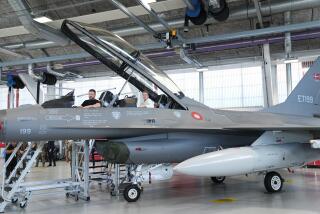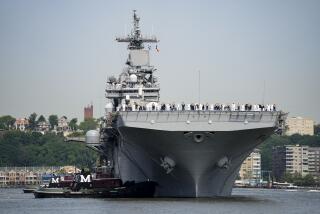Watch F-35 fighter come in for its first nighttime vertical landing
A F-35 fighter jet performed a key test flight for the U.S. Marine Corps last week when it hovered above a naval ship then came down to stick its first nighttime vertical landing.
Itâs a big milestone toward getting the radar-evading aircraft ready for combat by the end of 2015.
The first night vertical landing was accomplished Aug. 14 by test pilot Lt. Col. C.R. âJimiâ Clift aboard the USS Wasp at Naval Air Station Patuxent River in Maryland. It is part of an 18-day at-sea testing phase of the aircraft.
PHOTOS: F-35 fighter jet test flight program
âIt all went extremely well,â Clift said in a statement. âEight successful landings in one night, so weâre tracking favorably along the learning curve.â
Still the landing wasnât typical. The Wasp underwent a series of shipyard modifications to accommodate the F-35, including application of a new composite deck coating that offers additional heat protection and movement of lights and sensors to better support F-35 landings.
Marines said pilots will continue to expand the F-35âs envelope for launch and recovery, conduct the first night operations at sea, conduct initial mission systems evaluations at sea and evaluate the dynamic interface associated with aircraft operations on a moving flight deck.
The F-35, built by Lockheed Martin Corp., is a nearly $400-billion weapons program under development for more than a decade.
Lockheed is developing three versions of the F-35 for the Pentagon.
Called the Joint Strike Fighter program, it is centered around a plan to develop one basic fighter plane that could -- with a few tweaks -- be used on runways and aircraft carriers, and hover like a helicopter for joint use by the Air Force, Navy and Marines.
Each day, test pilots are expanding the edges of the F-35âs flight envelope at Edwards Air Force Base and Patuxent River.
If the plane is successful, it will be the first time that a fighter jet will have supersonic speed, radar-evading stealth and short takeoff/vertical landing capabilities.
The Pentagonâs long-term vision is to replace todayâs aging fighter fleets with 2,457 F-35s.
The Government Accountability Office estimated the program would cost an unprecedented $12.6 billion a year on average through 2037 â thatâs an average of about $1.4 million an hour for the next 2½ decades.
The per-plane cost estimates have climbed to $161 million today from $81 million in 2001, the GAO said.
The Marine version is expected to be the first of the three versions to go into service. Itâs scheduled to be delivered in 2015. The Air Force would be second to get operational F-35s when its version goes into service in 2016.
ALSO:
The Hyperloop: L.A. to S.F. in 30 minutes?
Upgrades aim to extend B-52 bombersâ already long lives
Area 51 revealed, home of secret spy planes, conspiracy theories
More to Read
Inside the business of entertainment
The Wide Shot brings you news, analysis and insights on everything from streaming wars to production â and what it all means for the future.
You may occasionally receive promotional content from the Los Angeles Times.










